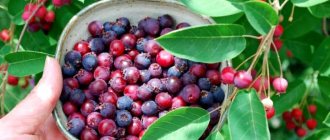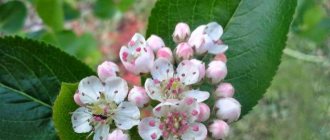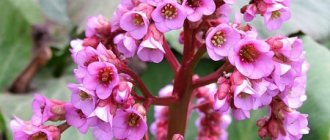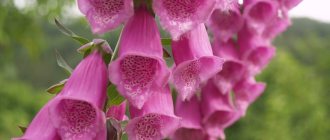Features of growing Spiraea Willow
Willow spirea is a beautiful and unpretentious ornamental plant.
Its large and at the same time graceful bushes will be an excellent decoration for the site not only for a professional gardener, but also for a novice amateur. And all because gray spirea does not require too complicated measures when planting and caring. Willow spirea or, as it is also called, gray spirea is a deciduous shrub and reaches a height of up to two meters. The plant received its first name because of the shape of its foliage. The leaves have a pointed shape and reach a length of up to ten centimeters.
They are darker on top than on the bottom. Gray spirea branches grow straight up. The bush grows very quickly due to a large number of root shoots.
This species is especially prized for the beauty of its blooms. Its color is described in a huge variety: lilac, pink, burgundy, garnet and many other shades of red. There are also bushes with white color.
In the wild, this plant is distributed throughout Eurasia, and also partially in North America. It grows in swamps, near reservoirs, but is also found in fields or in thickets of other shrubs.
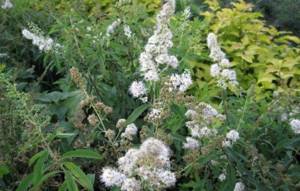
Decoctions and infusions from different parts of the plant are used in folk medicine to treat diarrhea, intestinal candidiasis, and rheumatism.
Two seasons are suitable for planting gray spirea - spring and autumn. In the first case, the plant should be planted until buds appear on the seedling. In the second - only after the leaves have fallen. The place for planting the plant should be open and sunny.
It is best to use bushes for group planting.
Gray spirea is not too picky about planting and care conditions, but there are certain points that must be observed to ensure good growth and health of the plant. First of all, it is best to plant it in rainy weather.
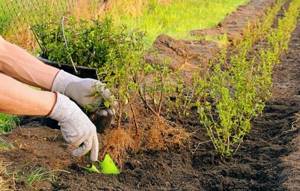
This plant is very moisture-loving and immediately after planting the seedling needs to be watered using at least thirty liters of water. But this is only if the bush is planted in the spring. If in the fall, then the young spirea must be protected from the cold for the winter.
The planting hole should be larger than the diameter of the roots, then the plant will grow better. Gray spirea has no special requirements for the composition or quality of the soil, the main thing is that it is fresh and moist.
But, if the soil for planting is too clayey, it is necessary to make drainage for water from sand and small crushed stone.
Planting and caring for willow spirea
Despite its visual attractiveness, willow spirea is unpretentious in care. It grows and blooms well under the most ordinary conditions. The only thing worth paying attention to is pruning the plant.
Preparation of planting material and site
For planting, it is advisable to choose 1-2 year old seedlings, which can have an open or closed root system. Before planting a plant with closed roots, it is removed from the container along with a lump of earth. Afterwards moisturize generously. If the earthen lump is too dry, then you need to soak it briefly in warm water.
Saplings with exposed roots should be tidied up. The first step is to trim damaged or dry areas. Excessively branched roots also require pruning. The above-ground part is shortened by 1/3 of the length. To improve survival rate, the root system of a loosestrife spirea seedling is dipped in a mixture of clay and cow dung.
For willow spirea, sunny, open areas are selected. The plant can also grow in partial shade, but the flowering will not be as abundant. The composition of the soil does not matter. It is preferable that it be fertile, loose and moist. The ideal option is turf or leaf soil. The required pH is 6-7.
Attention! To trim planting material, use garden pruning shears.

Planting willow spirea
For planting willow spirea in open ground, 2 seasons are suitable: spring and autumn. In the spring, it is important to plant the plant before the buds appear on the seedling, in the fall - after the leaves have dropped. When using group planting of spirea, the distance between plants should be 50 cm. The presence of lime in the soil is unacceptable.
- In the selected area, dig a hole 50 cm deep.
- The recess should be larger than the diameter of the root system. In this case, the bush will develop faster.
- A drainage layer of broken brick, crushed stone or expanded clay, 15 cm thick, is laid on the bottom.
- Fill the bottom of the hole with garden soil mixed with peat and sand in a ratio of 2:1:1.
- A sapling of willow spirea is placed in the center of the recess and sprinkled with earth. The root collar is not deepened too much; it should be 3-5 cm above the ground surface.
- The soil around the roots is carefully poured and compacted.
- At the end, 1-2 buckets of warm water should be poured under each bush.
- At the end of planting, the circle around the trunk is mulched with peat.
Advice! It is preferable to carry out the process of planting willow spirea in cloudy weather.
Watering and fertilizing
Spiraea loosestrife is a drought-resistant plant that requires moderate watering. On average, 15-20 liters of water per week is sufficient for an adult crop. During hot periods, the amount of watering should be increased. Young shrubs need more frequent watering until they take root. However, it is important to ensure that there is no stagnation of liquid.
The optimal time for fertilizing is early spring, before the flowering of willow spirea. Fertilize it with a complex of mineral and organic substances. To do this, dilute 10 liters of mullein in 6 liters of water. Then 7-10 g of superphosphate is added to the bucket of the resulting mixture.
Attention! In fertile soils, willow spirea can grow for several years without fertilizer.
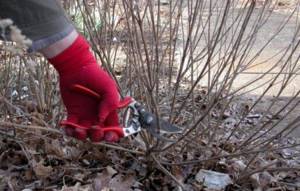
Trimming
The pruning procedure for willow spirea is carried out at the end of flowering, that is, in the fall. However, there is no need to shorten faded shoots, as this will provoke the growth of lateral branches, on which small, inexpressive flowers will appear. The shape of the bush will also be disrupted, and the effect of flowering shoots drooping to the bottom will be spoiled.
Summer-flowering spirea begin to be pruned with the arrival of spring, and only those plants that are at least 4 years old. As a result, the bush will remain 20-30 cm tall. If this is not done, the willow spirea will lose its decorative shape, the long branches will deviate to different sides, leaning towards the ground. And if you remove only the upper part of the shoots, then the young shoots will be extremely thin, with inflorescences of insignificant size.
Preparing for winter
As a rule, willow spirea does without shelter in winter. It can tolerate frosts down to -45-50 °C. However, if a harsh and snowless winter is expected, then it is worth providing the plant with proper wintering. The circle around the trunk is mulched with hay or straw, the roots are covered with dry spruce branches. The branches are tied into a bundle and covered with burlap or agrofibre.
Reproduction
Gray spirea can be propagated in two ways: by planting seeds or cuttings.
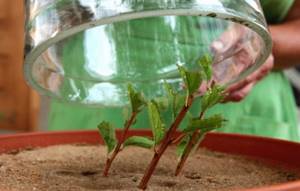
The first method is simpler and does not require any complicated measures. First, you need to collect the seed pods from the bush while they are not yet open and brown in color. It is better to do this at the end of summer.
Literally two weeks later the boxes ripen and open. The resulting seeds do not require additional processing and are ready for planting. It is better to first place the seeds for three months in special soil, distributed among boxes.
Propagation by cuttings gives a slightly higher success rate in terms of survival, but also requires more effort. It should start in mid-summer or early autumn. Young shoots no more than a year old, growing almost vertically upward, are best suited for cuttings.
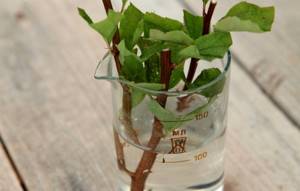
They need to be trimmed, leaving about five leaves on each cutting. The resulting cuttings should be soaked overnight in a special Epin solution in the proportion of one milliliter to two liters of water. Next, the cuttings are planted in wet sand at an acute angle.
After this, they should be covered with film or a glass cap and sprayed regularly. Young seedlings should be located in a shady place. For the winter, it needs to be sprinkled with fallen leaves, and then planted in the spring when the first shoots appear.
Read also: Cucumber Tufted splendor F1 variety characteristics, features and reviews
Gray spirea is quite undemanding in its care. It consists of regular watering, fertilizing and periodic pruning of the bush.
Spiraea loosestrife requires moderate watering. It is necessary to increase its volume only during the dry period. At this time, each bush needs about fifteen liters of water per week.
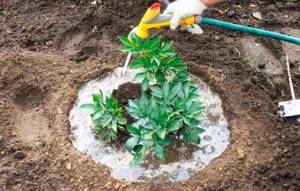
The best time to fertilize the plant is in the spring, before the spirea begins to bloom. To do this, you need to mix a bucket of manure in five buckets of water. You will need to add from five to ten grams of superphosphates to each bucket of the resulting mixture.
To prevent weeds, the soil around the bush should be mulched with humus, peat or wood shavings.
Regular pruning of gray spirea branches is required not only to care for the appearance of the crown, but also for better flowering of the shrub. Pruning should be done in early spring so that the plant has time to recover before summer flowering.
Diseases and pests
The main pests for willow spirea are aphids, rose leaf miner, roseate leaf roller, spider mites and slugs. To combat them, you can use not only chemical, but also biological and agrotechnical methods.
Even regular watering and fertilizing the bushes helps protect against diseases and pests. Maintaining order and cleanliness in the garden and the area around it also helps.
Aphids, miner and leafworm can be successfully destroyed by adding a pyrimor solution to the soil. And treating the plant with phosphamide, metaphos, fozalon, etc. will help get rid of spider mites.
In turn, the most basic way to drive slugs away from your plants is to spray them with a coffee solution.
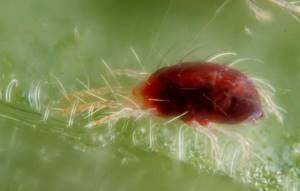
Any preventative treatments should be carried out before the first leaves appear on the bush. These procedures are carried out every spring and autumn. In general, the bush rarely receives serious damage from pests and usually does not lose its decorative appearance.
So, we learned that willow or gray spirea is an amazing plant. It not only has an attractive appearance, but is also not picky about planting and care conditions and even has recognized healing qualities. This means that this shrub is quite worthy of becoming an adornment of your garden.
Description of the variety
Willow spirea is a very unpretentious plant that grows mainly in Asia and Europe. In Russia, it is found growing wild, mainly in the Far East and Siberia. Since the variety loves moist soil, it grows mainly in floodplains, swampy areas, and near lakes.
Willow spirea is a fairly tall, upright growing shrub (reaches 2 m in height) with smooth or granite-striped shoots of a reddish-brown color (sometimes with a yellow tint). The leaves of the plant are pointed, not very large - about 10 cm in length, dark green in color (light green on the underside).
The short flower stalks of the plant are pink/white and collected in small panicles, reaching a length of 15-20 cm. The plant is very resistant to adverse conditions: frost-resistant, floriferous, viable (surprisingly, the seeds of the plant survive in 100% of cases).
Most often as a decorative element for gardens, sidewalks, city flower beds, etc. It takes root well in urban environments due to its resistance to gas, smoke, etc.
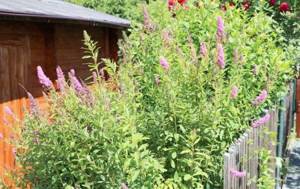
The flowering of the variety usually begins by the end of spring and ends by mid-summer, but in some cases it can bloom again, although not as magnificently as the first time.
Read also: Volga beauty plum variety: description, photos, reviews, cultivation, care
Advice. Among the several decorative forms in which the variety in question is represented, special attention should be paid to the large-flowered Spiraea, which is distinguished by its incredibly beautiful large flowers of pale pink color.
Description of varieties
In total there are about 100 species of this shrub. The plant is unpretentious , but requires planting in high-quality, fertile soil. Some species are frost and drought resistant.
Depending on the species, spirea can be very different, they come in different shapes and shades, some can even change their color as the seasons change. There are spring and summer spirea. The spring species blooms for a much shorter time.
The duration of flowering in summer spirea is longer, and the flowering is more abundant.
The plant begins to bloom in the third year of life. Moreover, the first flowering will be quite sparse - there may be only a few flowers. Spring spirea blooms, as a rule, in all shades of white . The spring shrub is distinguished by its lushness .
Summer spirea blooms in the summer. Inflorescences bloom at the tips of the branches. Shrubs are used for various purposes: in landscape designs, in parks, in hedges, even for medicinal purposes.
The most striking representatives of the spirea species:
- Spiraea willow;
- billard;
- Douglas;
- St. John's wort.
Each type of shrub is beautiful in its own way and has its own individual characteristics.
Appearance
Spiraea can creep along the ground, can be lying, spreading and erect.
Shades can be completely different. The bark on the bush may peel. The root system is usually lumpy. The leaves of the plant can be of different shapes - from willow-like to round. They are located one after the other.
The flowers are small , collected in large inflorescences. Inflorescences can be located at the ends of branches or along the entire length of the shoot. You can propagate shrubs in 4 ways:
- layering;
- cuttings;
- seeds;
- dividing the bush.
Reproduction is easy, without any difficulties.
Spiraea wavy
This representative of the meadowsweet prefers moist soil, so in nature it prefers to grow in swampy places or at the mouth of rivers.
The plant is a tall, about 2 meters in height, upright growing shrub. The leaves of the plant have sharp tips, are green, and not very large. The flowers are pale pink, collected in inflorescences. Each inflorescence is approximately 15−20 cm long. These are lush-flowering, frost-resistant, viable plants. Spiraea loosestrife is one of the few plants that has 100 percent seed germination. Survives well in urban environments. Does not react at all to atmospheric pollution from exhaust gases and smoke.
It begins to bloom around the end of spring, flowering continues until mid-summer. Often the plant may bloom again, but the flowering will no longer be as abundant. Spiraea loosestrife feels comfortable in the climatic conditions of the middle zone.
Billard variety
As a rule, both experienced gardeners and beginners choose the most spectacular types of meadowsweet for planting.
Spiraea billarda belongs to this species. The plant in nature prefers to grow in mountainous or steppe areas. This species has various shapes and shades. Its shape can be round, cascading or pyramidal.
Foliage tends to change color. It can be green or silver. During the fall season, the bush changes foliage color and acquires yellow, violet and purple leaf colors.
The flowering of this species of meadowsweet, compared to other representatives, is long-lasting. It blooms with small flowers, which are collected in lush inflorescences. The flower can be from white to lilac and crimson. Like all meadowsweet, billard spirea is divided into spring and summer. The plant tolerates frost well, which is why almost all northern gardeners love to grow it in their garden.
Meadowsweet is completely unpretentious and does not require any additional care. The only condition for care is spring pruning.
Characteristics of the Douglas species
An ornamental shrub belonging to the rose family, it can be found in nature in the desert, mountains, forests and forest-steppes.
The shrub grows up to 1.5 m in height, up to 2 m in width, grows upright, its shoots are red-brown in color. The leaves are oblong, lacent, up to 3−10 cm in length, silvery in color.
The shrub blooms with small pink flowers, which are collected in small pyramidal inflorescences located throughout the shoot. The inflorescences cover the entire bush. Flowering duration is 45 days from July to September. The flower grows and develops well and quickly. Frost-resistant and unpretentious. After flowering, the plant begins to bear fruit. Meadowsweet begins to bloom at 3-4 years of age.
Meadowsweet is widely used for decorative purposes. It can be seen in landscape designs, more often in personal plots; in addition, it takes root well in personal pools or artificial fountains. It is planted on the edge of a reservoir, thereby creating the effect of natural beauty. Planting and care are no different from other plants of this species. Care requirements are the same as for other meadowsweets.
Spiraea ashy or St. John's wort
Spiraea St. John's wort is an ornamental hybrid.
Its second name is ashy. During its flowering, the shrub is simply beautiful. Meadowsweet buds of this species begin to form in the fall, so pruning is done immediately after flowering. In nature, it can be found in forest-steppes and steppes. The shrub can reach 2 m in height. Its foliage is grayish in color. After 10-15 years, meadowsweet needs to be rejuvenated. This can be done by cutting off all shoots to a stump. Representatives of this species are frost-resistant, love sun or partial shade, and are not susceptible to drought. The plant is pruned, grows quickly, is not whimsical. Meadowsweet blooms with small white flowers, which are collected in small inflorescences located along the entire branch of the plant.
Features of care
Spirea loves sunny places, but will also feel comfortable in partial shade. When choosing a suitable site for planting a plant, it is better to give preference to moist, fertile soil. If it is depleted, no problem: just feed it with a mixture of turf, peat and sand (in a ratio of 2:1:1).
It is best to plant the variety with the arrival of autumn. In this case, it is advisable to choose cloudy weather, or even drizzling rain. If group planting is carried out, the distance between individual seedlings should be at least half a meter.
When planting, make sure that the root collar of the seedlings remains on the surface of the soil. After planting, be sure to provide the soil with high-quality drainage from fine sand and finely crushed bricks.
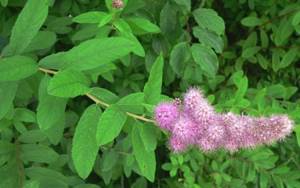
If the plant is grown for the first time, then a short time after planting it is necessary to mulch the area with the Spirea planted with a layer of peat (the thickness of the layer should be about 7 cm).
Advice. In persistently rainy weather, pay special attention to the condition of the soil, as it may become covered with a layer of dense crust. In this case, the area will require regular weeding and loosening.
As for pruning an actively growing plant, its timing directly depends on the type of Spiraea loosestrife. Depending on the location of bud formation, the plant is divided into:
- Early blooming. Removal of shoots from a plant of this group is carried out only when it reaches 7 years. Moreover, only old shoots are cut off. Young ones cannot be removed every year, otherwise the plant may simply not bloom in the year of pruning.
- Late flowering. Plants belonging to this group, on the contrary, require annual pruning in early spring (even before the plant begins to awaken from winter “hibernation”).
In general, the variety is distinguished by its unpretentiousness to growing conditions, and also pleases with consistently luxurious flowering. Good luck!
Willow spirea: description, varieties and agricultural technology
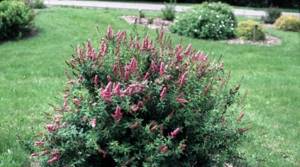
Spiraea salicifolia (Latin name Spiraea salicifolia) belongs to the large Rosaceae family. The plant has the appearance of a not very tall shrub with a picturesque crown and graceful inflorescences. In addition to its bright appearance, the bush is unpretentious and easy to care for.

Description
The willow spirea belongs to deciduous crops, its maximum height is 2.5 m. Its crown is dense, round in shape, with ribbed shoots of a brown-yellow tone. The leaf blades are lanceolate in shape with a wedge-shaped base and pointed apexes. They grow alternately, on short petioles. The edges of the leaves have a sharp, dusty shape, the surface of the plate itself is smooth.
The upper side is dark green, while the lower side is light green. The leaf length is on average 5-7 cm, although sometimes it is 10-11 cm, and the width is 1-3 cm. The flowers have the appearance of bells, which are collected in voluminous panicles with cylindrical or pyramidal outlines. Their length can reach 20-25 cm.
The flowering of the shrub begins in early or mid-summer and differs in abundance and duration.
The buds of the willow spirea are white or pink. The bush begins to bloom 4-5 years after planting. After flowering ends, small green fruits with flat brown seeds inside ripen on the shoots. The roots of the plant are located near the surface. In its natural environment, willow spirea has a fairly wide growing area: it covers almost the entire territory of Europe and Asia.
The species has also become widespread in North America. It prefers clayey and moist soil near water bodies. Like willow, spirea often grows in coastal areas of rivers, lakes or swamps. The species is classified as frost-resistant. This variety is characterized by fairly rapid growth.
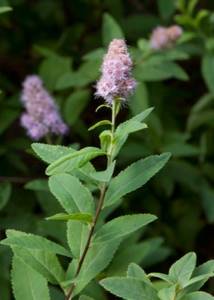
Popular varieties
Spiraea loosestrife does not have a wide variety of varieties, but all its forms are distinguished by beautiful and lush flowering, as well as voluminous luxurious crowns.
"Alba"
Representatives of the variety are about 2 m high, and their crown is the same size. It has the shape of a wide oval with elongated bright green leaf blades. The shrub is distinguished by its rapid growth; the roots also grow in a fairly short time. Alba (translated from Latin as “white”) stands out for its snow-white paniculate inflorescences; they appear at the end of June on young shoots. The shrub blooms in abundance, the buds delight the eye with their beauty for more than a month.
The plant lends itself well to pruning without losing its decorative properties. Regular garden soil is suitable for this variety.
It is better to choose a site that is well lit or slightly shaded; in the absence of light, flowering will be sparse. Snow-white shrubs look beautiful in the form of a hedge, group planting, or simply as a separate bush on a green lawn background.
"Grandiflora"
The height of the bush is 1.5-2 m. The shoots are erect, with light brown bark; on young branches it is reddish-yellow. The crown of the plant is quite dense, round in shape. The leaf blades have a solid surface and are quite large in size, unlike other varieties. The leaf shape is lanceolate, with a pointed apex.
The top side has a richer dark green color, while the back is much lighter. In autumn the crown takes on orange-red hues. The buds of "Grandiflora" (which means large-flowered) are large in size; they are collected in lush light pink cylindrical inflorescences. Panicles can reach up to 20 cm in length. The flowering of the bush lasts about 3 weeks.

The variety is characterized by fairly rapid growth, but relative fragility. The life cycle lasts 15-20 years. The plant prefers sunny areas, but can also grow in partial shade. Spiraea does not require special conditions, but prefers well-moistened soil. The shrub is perfectly adapted to city conditions and does not suffer from increased gas pollution.
It is also distinguished by a high threshold of winter hardiness. The variety is used for landscaping streets, parks and squares.
Spiraea “Grandiflora” is also planted in apiaries, because this plant is an excellent honey plant.
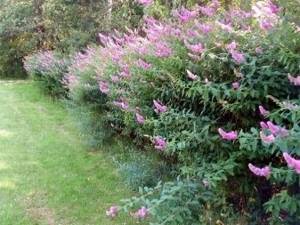
"Billard's"
The variety belongs to the late-flowering hybrids of willow spirea. The bush can reach a height of up to 2.5 m. The shoots are straight, spreading, densely covered with leaves, old branches are bare, with pronounced ribbing. The leaf blades have dusty edges, the shape is elongated, lanceolate, their length is about 10 cm. The underside of the blades is painted in grayish tones.
With the beginning of autumn they acquire brown-red shades. The buds are not particularly large, but have a pleasant sweetish aroma. Dense panicle inflorescences have a narrow, elongated shape, reaching 20 cm, and a delicate bright pink color. The flowering is lush, begins at the end of summer and lasts almost until mid-autumn. Representatives of the variety are light-loving, hardy and drought-resistant.
In addition, spirea is very resistant to frost and is completely unpretentious to care for. Shrubs are planted as a hedge, as well as in single and group plantings.
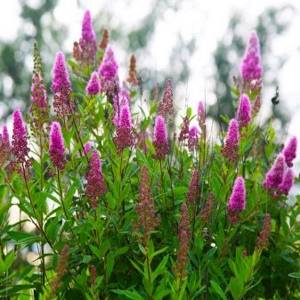
Growing rules
The willow spirea is distinguished by its undemanding conditions, but still, for normal growth, as well as lush and long-lasting flowering, it is worth paying a little attention to it. In order for the plant to grow well and quickly, when planting a shrub you need to take into account some nuances.
- The timing for planting shrubs should be selected in the spring, before the formation of buds on the shoots, or in the fall, after the plant sheds its leaves. The optimal time is a cloudy morning or evening, as well as a rainy day.
- The choice of location mainly depends on the plant variety, but in general the willow spirea prefers well-lit areas.
- Soil preparation consists of mixing two parts earth, one part sand and the same amount of peat. This mixture is well suited for rooting shrubs. It is also necessary to provide the plant with drainage.
- The planting scheme depends on its type: single or group, but the algorithm of work is the same. The holes make the seedling's root system slightly larger by about a third. The roots should be placed spaciously in the recess, and the root collar should be on the same surface as the ground. The soil around the seedling is crushed and watered; it is also worth applying a layer of mulch. When planting in groups or in the form of a hedge, it is necessary to take into account the size of the growing bushes and leave a distance of 0.5-1 m between them.
Recommendations for planting, care and propagation of willow spirea
Every gardener dreams of having a plant on his or her plot that is both unpretentious and frost-resistant, and also has long-lasting flowering. The Spiraea bush is famous for these qualities. In this article I will introduce you to one of the species of this beautiful plant, and also tell you about the intricacies of care and cultivation.
Spiraea is a genus of deciduous shrubs of the Rosaceae family, which includes about a hundred species. One of the most famous varieties is the willow spirea. It is popular not only for its decorative qualities, but also for its medicinal properties.
The bush can be spring-blooming or summer-blooming. The first type of plant begins to bloom in spring and its inflorescences look like umbrellas. The flowering period of the latter occurs after June with pyramidal inflorescences. Willow belongs to the second group.

Description of the plant and photo
Spiraea salicifolia belongs to the perennial ornamental deciduous shrubs of the Rosaceae family. So named because of the shape of the foliage, which is similar to the foliage of willow. The natural habitat is Europe and Asia, Siberia, as well as the northern part of America. Grows near lakes, along the banks of reservoirs, in wetlands.
The culture has the following botanical description:
- A fast growing shrub about 2.5 m high.
- The stems are erect, bare, slightly ribbed, brownish-yellow in color.
- The crown is dense, round in shape.
- The leaves are lanceolate, alternate, with an average length of 4.5-7 cm, with a wedge-shaped base and pointed tips, on short stalks. The leaf blade has a sharp-serrate shape, its upper side is smooth, dark green in color, and the lower side is light green in color.
- The flowers are pink or white, collected in paniculate inflorescences up to 20-25 cm long, narrow pyramidal or cylindrical in shape, located at the ends of the shoots. The plant shows its first color 4-5 years after planting.
- The fruits are small, green in color, ripen after flowering, and contain brown seeds inside.
Features of willow spirea
It grows mainly in Europe and Asia. Often found in Russia as a wild plant. Mainly in the Far East and Siberia. The culture loves moisture, so it can be found near lakes, ponds or swampy areas.
The plant grows up to a maximum of two meters. The shrub got its name due to the shape of the leaf, which resembles the willow tree leaf of the same name. The leaves are pointed, glabrous, on short petioles. The upper side of the leaves is dark green and the underside is light green. The length varies from 4.5 cm to 7 cm, sometimes reaching 10 cm. Their width is 1-3 cm.
Beautiful flowering can be seen in this species. Bushes come in shades of purple, red, pink and even white. Fluffy flowers are collected in paniculate inflorescences and are approximately thirty centimeters long. Flowering begins four years after planting.
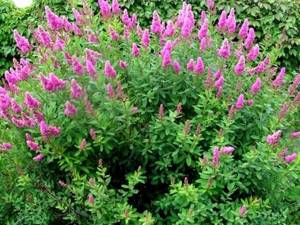
Spiraea is considered an unpretentious shrub. She will not need much attention in matters of planting. However, some points should be followed for the good development of the plant.
Planting shrubs can be done both in autumn and spring. In the spring, you need to be in time before the buds appear on the bush. And in the fall, after the leaves have fallen. The site for the future bush should be in an open place, protected from cold winds and with sufficient sunlight. It is worth remembering that it is best to plant a seedling in rainy weather.
- We dig a hole about fifty centimeters deep.
- Place leaf humus at the bottom of the hole.
- We plant a seedling. For better growth of the shrub, its roots should fit freely into the hole.
- Water with three liters of warm water.
- Fill with soil and tamp lightly.
Read also: Felt cherry Natalie: description of the variety, photos, reviews - Popular about health
In the first week after planting, daily watering and weed removal are required. Mulching with sawdust or straw will help retain moisture in the soil.
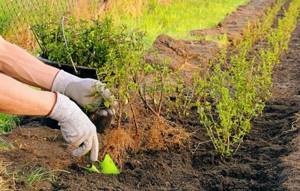
Types and varieties of spirea
There are two types of spirea: blooming in spring and summer.
Spring-blooming spirea
Feature: early bushy flowering of last year's shoots with white flowers. This group of spirea includes the following species:
Spiraea gray
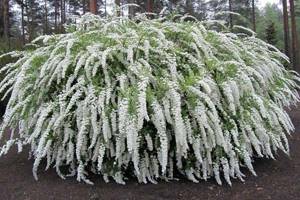
Spiraea gray
A hybrid plant, about two meters high. Branches falling down; the flowers are snow-white, located throughout the shoot; leaf blades are gray-green.
Flowering time: from May to mid-June. Wintering species. Seed propagation is excluded due to hybrid origin.
Of the varieties of this species, the most common is grefsheim.
Spiraea Wangutta

Spiraea Wangutta
Hybrid bush two meters high. Drooping shoots. Small clusters of white flowers form umbels and cover the entire shoot. The leaves are blue-green. Vangutta begins to bloom in May and early June.
It is successfully used as a natural fence and goes well with other varieties of bushes or trees, for example, maple or conifers.
One of the common varieties of spirea Vangutta is the winter-hardy pink ice (catpan).
Spiraea nipponensis

Spiraea nipponensis variety "Snowound"
This culture comes from Japan. Spiraea Nipponica reaches a height of two meters. A bush with a dense spherical crown, horizontal shoots. Snow-white inflorescences fill the entire branch. Flowering lasts about three weeks, from the end of May to the first days of June. The culture survives the winter well. Varieties of Nippon spirea include snowmound and halward's silver.
Spiraea arguta (sharp-toothed)
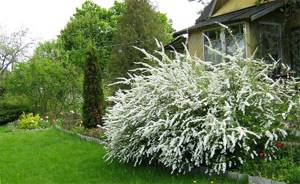
Spiraea Arguta
Hybrid branched shrub up to two meters tall. The falling shoots are abundantly strewn with whitish flowers collected in inflorescences. The leaf blades are thin, bright green.
Of all the spirea species in this group, arguta is the earliest to flower. Flowering lasts 21 days from the end of May. It stands out for its abundant flowering.
Compacta is a cold-resistant variety of Spiraea serrata.
Summer flowering
Feature: inflorescences cover the edges of young shoots, last year's branches dry out. They bloom predominantly with red-pink flowers. This group of meadowsweet includes:
Spiraea japonica
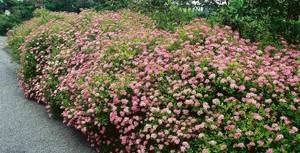
Spiraea japonica variety "Little Princess"
A magnificent shrub, up to 1.5 m high. Brought to us from Japan and China. The leaf blades are oblong, green on top and bluish below. In autumn they turn yellow or red. Flowers of pink tones, collected in inflorescences. It blooms for a month and a half. In the spring, Japanese spirea needs to be pruned.
This species will be a good decoration for flower beds.
Among the numerous varieties of this species, we can note such as spirea princess (little princess, golden princess), macrophylla, candlelight, gold flame, gold mound.
Spiraea Boumalda

Spiraea Boumalda variety "Anthony Waterer"
Hybrid look. Bush of spirea bumalda of low growth up to 80 cm. The branches are straight. The leaf blades are green in summer and in autumn they acquire a beautiful red-yellow color. Flowers in different shades of pink. Flowering is quite long, up to 60 days, starting in July.
Varieties: anthony waterer, Dart's Red.
Spiraea looseleaf
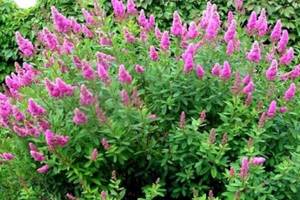
Spiraea looseleaf
A two-meter bush with straight smooth branches of a red-brown color. The leaf blades are long (up to 10 cm), pointed. The flowers are white and pink, forming pyramidal inflorescences up to 20 cm long.
Spiraea willow is resistant to cold weather.
Spiraea douglas
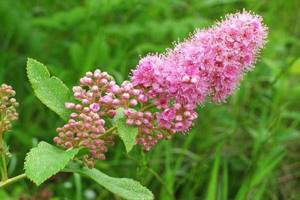
Spiraea douglas
Imported from North America. Shrub 1.5 m long. The branches are straight, red-brown in color. The leaf blades are oblong in shape, with a pointed tip and base. Up to 10 cm long.
Flowers of lilac color are collected in pyramidal inflorescences on the tops of the shoots. Flowering lasts 45 days starting in July.
Spiraea Billarda
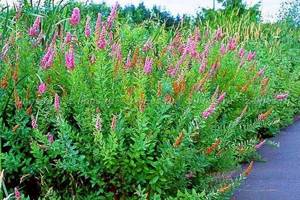
Spiraea Billarda
Hybrid two-meter bush. The shoots are spreading. The leaf blades are wide, reaching 10 cm in length. The flowers are pink, forming pyramids of 20-centimeter narrow inflorescences. Flowering begins in mid-July.
The plant is a species resistant to winter conditions.
Reproduction
The plant is propagated in several ways:
This method is considered the easiest and fastest. With its help it is possible to obtain a large number of shrubs at once. No special preparation is required for seeds.
In August, twigs with seed pods are collected. They should not be open and have a dark brown tint. After a couple of weeks, the boxes open and the seeds are collected for sowing. First, they are planted in boxes with special soil containing vermiculite and peat. Next, when the sprouts appear, they are planted in the garden bed.
With this method, all varietal qualities are successfully preserved. However, more effort will have to be made here.
Reproduction begins in July and mainly selects annual shoots that grow strictly vertically. Next, cuttings are cut from them, leaving four or five leaves on each. For half a day, the cuttings are soaked in a rooting solution with water in a ratio of 2 liters to 1 milliliter. For root formation, fertilize with a powder stimulator. The cuttings are planted in moistened sand at an angle of forty-five degrees.
The cuttings are left in a dark place, protected from drafts. Cover with film and spray regularly before the onset of cold weather. During the winter, the pot is covered. With the arrival of spring, they are planted in open ground.
You can find out more information about the willow spirea in the video link below.
The whole process of caring for a plant mainly consists of constant watering, fertilizing and pruning bushes.
Spiraea loosestrife requires timely and moderate watering. During drought, one bush receives about 15 liters of water per week.
The best time for fertilizing is considered to be the spring, namely the time before the bush begins to flower. A bucket of manure and five buckets of water are used as top dressing. Ten grams of superphosphates are added to a bucket of the mixture.
Pruning branches is useful both for decorative quality and to improve the flowering quality of the plant. Pruning is done with the arrival of spring so that the plant has time to recover before the flowering season.
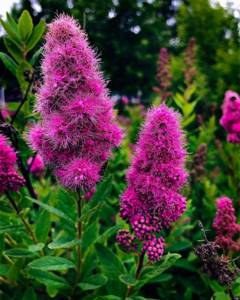
Care
The whole process of caring for a plant mainly consists of constant watering, fertilizing and pruning bushes.
Spiraea loosestrife requires timely and moderate watering. During drought, one bush receives about 15 liters of water per week.
The best time for fertilizing is considered to be the spring, namely the time before the bush begins to flower. A bucket of manure and five buckets of water are used as top dressing. Ten grams of superphosphates are added to a bucket of the mixture.
Pruning branches is useful both for decorative quality and to improve the flowering quality of the plant. Pruning is done with the arrival of spring so that the plant has time to recover before the flowering season.





